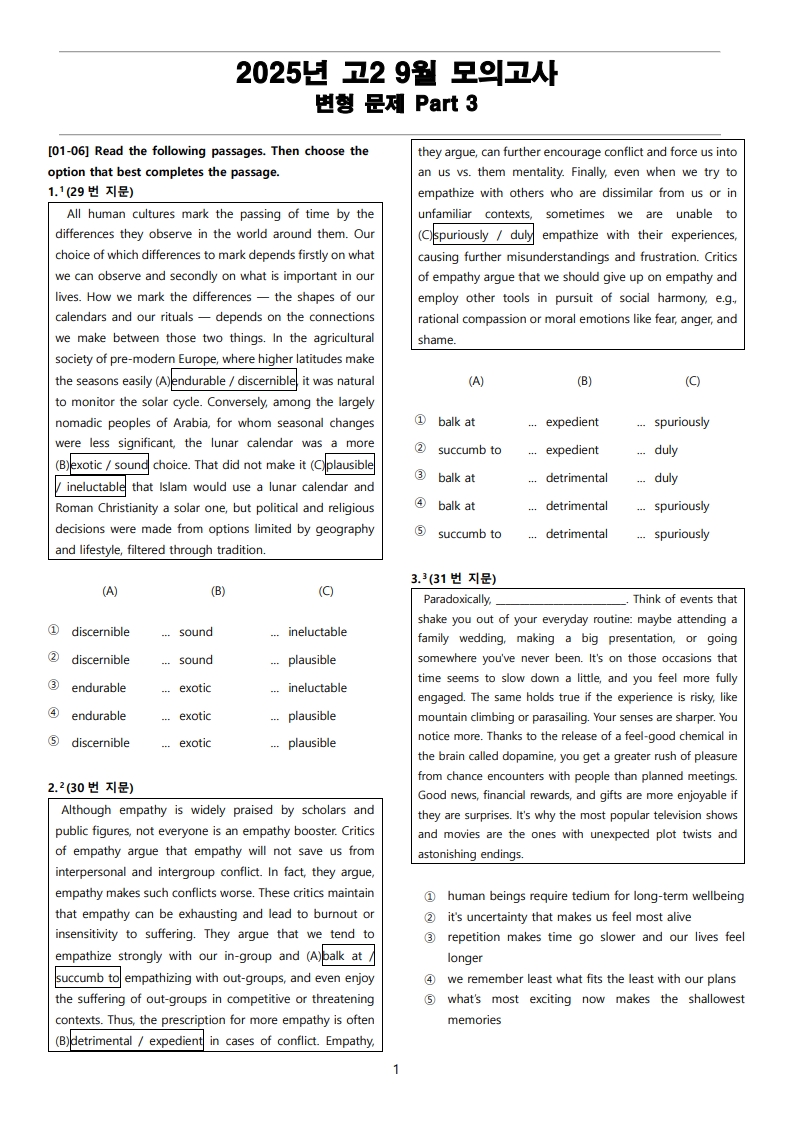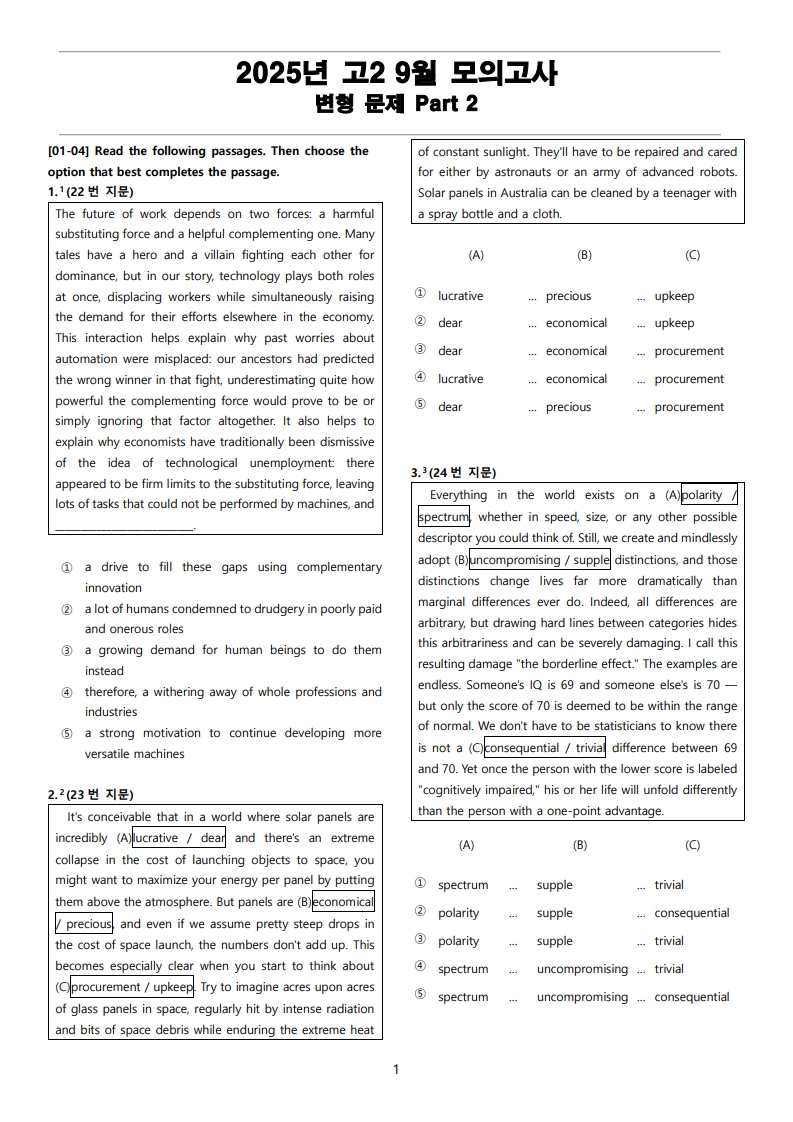2025년 고1 10월 전국 연합 모의고사
변형 문제 Part 4
일반 워크북 형태의 문제에서 벗어나 The Makings가 만든
2025년 고1 10월 전국 연합 모의고사 변형 문제 Part 4
출판사에서 오랫동안 영어 번역과 교정을 하셨던 원어민 선생님과
현직에서 강사를 하고 있는 연구진들이 학생들을 위한 최상의
2025년 고1 10월 전국 연합 모의고사 변형 문제 Part 4를 선보입니다.
사고력과 이해력을 요구하는 문제들로 내신 대비 뿐만이 아니라
수능도 한꺼번에 공부하실 수 있는 자료입니다.
중간고사&기말고사 전에 더메이킹스(The Makings)에서 제작한
2025년 고1 10월 전국 연합 모의고사 변형 문제로 마무리 하세요.
정답 확인 하러가기!
https://themakings.co.kr/226/?idx=1195
2025년 고1 10월 전국 연합 모의고사 변형 문제 Part 4
2025년 고1 10월 전국 연합 모의고사 변형 문제, 내신대비, 영어내신자료,고등영어자료, 모의고사 변형문제,전국 연합모의고사 변형자료, 모의고사 영어 서술형 대비, 대치동 고등 영어자료, 대치
themakings.co.kr
The Makings의 2025년 고1 10월 전국 연합 모의고사 변형 문제 Part 4는
총 11개의 유형으로 구성되어 있습니다.
1. 빈칸 채우기(객관식)
2. 글의 내용 일치/불일치(객관식/한글 선택지)
3. 글의 내용 일치/불일치(객관식/영어 선택지)
4. 글 끼어 넣기(객관식)
5. 어법(서술형)
6. 어휘(서술형)
7. 주제문(객관식/영어 선택지)
8. 어휘 빈칸 채우기(서술형)
9. 영작(서술형)
10. 요약문 완성하기(서술형)
11. 문단 재배열 하기(객관식)
더메이킹스(The Makings)가 제작한
2025년 고1 10월 전국 연합 모의고사 변형 문제 Part 4의 지문입니다.
1번 지문(문항 번호 35번)
Social media serves as an important context to facilitate autobiographical remembering. Personal events posted on social media platforms are better remembered and less forgotten than those not posted, independent of the characteristics of the events. This may be because sharing memories online allows individuals to rehearse and make sense of what happened, thus facilitating long-term memory retention. Online feedback such as comments and likes as well as technological features such as algorithms and periodic reminders can further serve as memory cues for the posted event details. As a result, event details shared on social media are likely stabilized and remembered over time, whereas those not shared may become inaccessible or forgotten.
2번 지문(문항 번호 36번)
Multisensory experiences are a central part of our everyday lives, yet we often take them for granted, especially when our senses function normally or are corrected to normal with aids like glasses. However, closer inspection to any, even the most ordinary experiences, reveals the remarkable multisensory world in which we live. Consider the experience of eating a regular meal. At first, it may seem like an ordinary experience, but it is actually a fusion of the senses. We first eat with our eyes, but we are also exposed to countless sensory signals that influence our eating experience such as food textures, tastes, and smells. And it does not stop there. Even the sounds that come both from the atmospheres in which we eat and our interactions with the food (such as chewing) and the tools we use to eat influence our eating experience.
3번 지문(문항 번호 37번)
As children, the principle of opposites is foreign. Children perceive words and their meanings separately from each other. It is only in later development that we understood that individual words directly connect to one another. For many children, for instance, it is not clear that 'Right' is the opposite of 'Left'. A vivid example of this can be seen when children learn to ride a bicycle. If parents tell their child "Don't go to the left," they will often find that the child will continue riding straight ahead and not automatically turn to the right. The same applies to the logical connection between 'Yes' and 'No' as perceived by parents. When we were children and were told, for example, "No, don't eat with your hands," we were confused and didn't know what our parents expected from us. Our confusion was about whether we should continue eating or not and if so, how? Only later did we recognize the connection and understand that we should continue eating, but not with our hands but with a fork or a spoon.
4번 지문(문항 번호 38번)
Humans are not the most social animal. Ants, bees, and termites put humanity to shame on many metrics of sociality. A wide variety of relatives live together with perfectly harmonious behavior and collectively care for their young. But while insect colonies are impressively social places, it's not our kind of social life. Bees always build hexagonal hives, ants march in lines, and termites move in zigzag formations. These patterns recur predictably because they are tightly programmed genetically and propelled pheromonally. We humans are more free, less tightly programmed genetically, so our social patterns can be more diverse and dynamic. Every group dances a slightly different dance, and these choreographies change across generations. We still think and act in ways that are in harmony with others around us, but it is through patterns that are more shaped by nurture, not just nature.
5번 지문(문항 번호 39번)
Those who purchase the goods of a company are called customers. Individuals who purchase goods for personal use are called consumers: beings who consume. Therefore, companies have invented multiple ways to ensure that their customers consume the produced items in larger and larger quantities and more and more frequently. Those who sell food have an easy time, for food is literally consumed, so there is always a need to purchase new food. But with more permanent things, companies must invent reasons for their customers to continue to consume them. One approach is to make the stuff that people already have outdated by convincing them that it is no longer fashionable. The entire fashion industry is built to convince people that fashion matters, so they must purchase new clothing, even though the old is still perfectly functionable. Fashion today extends to far more things than clothes: automobiles, mobile phones, computers ― the list is extended indefinitely, limited only by the limits of the creative minds of the marketing divisions of companies.
6번 지문(문항 번호 40번)
Kivetz, Urminsky, and Zheng partnered with a cafe to test the motivating effect of illusory progress in an experiment. Customers received a reward card that offered one free coffee after they'd bought ten. While half of the customers received a card with ten open slots, the other half got a card with twelve open slots. Yet the twelve-slot card had two preexisting "bonus" stamps, so, strictly speaking, these were identical reward programs. Every customer who got a card needed to make ten coffee purchases (and collect ten stamps) to get their free coffee. But the appeal of the free stamps was high. People who thought they'd gotten a head start came back to the cafe more often, filling in their reward card more quickly than the others. When the card came with two out of twelve slots already filled, it felt to customers like they were already 16 percent finished with the goal before they'd even started. Believing they were closer to the reward, they were more motivated to reach the finish line.
'전국 연합 모의고사 변형 문제 > 고1 모의고사 변형 문제' 카테고리의 다른 글
| 2025년 고1 10월 전국 연합 모의고사 변형 문제 Part 3 (0) | 2025.11.28 |
|---|---|
| 2025년 고1 10월 전국 연합 모의고사 변형 문제 Part 2 (0) | 2025.11.26 |
| 2025년 고1 10월 전국 연합 모의고사 변형 문제 Part 1 (0) | 2025.11.25 |
| 2025년 고1 9월 전국 연합 모의고사 변형 문제 Part 4 (0) | 2025.09.11 |
| 2025년 고1 9월 전국 연합 모의고사 변형 문제 Part 3 (0) | 2025.09.09 |








